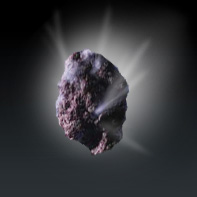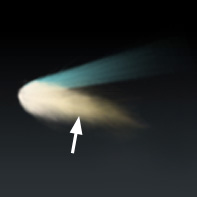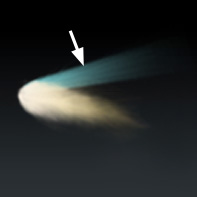Comets
Comets are irregularly shaped bodies made up of ice, dust and frozen gases.
The diagram below shows the structure of a comet.

Nucleus |
 This is also called the core and is the only permanent solid part of the comet. It is irregular in shape and typically very dark with an approximate diameter of 3 kilometers. The nucleus is made up of ice mixed with large amount of dust particles. Because of this mix of dust and ice a comet is sometimes described as a dirty snowball. The ice in the nucleus of a comet consists mainly of frozen water with smaller amounts of frozen gases. This is also called the core and is the only permanent solid part of the comet. It is irregular in shape and typically very dark with an approximate diameter of 3 kilometers. The nucleus is made up of ice mixed with large amount of dust particles. Because of this mix of dust and ice a comet is sometimes described as a dirty snowball. The ice in the nucleus of a comet consists mainly of frozen water with smaller amounts of frozen gases.
|
Coma |
 As the comet approaches the sun it undergoes some structural changes. The heat energy from the sun causes some of the ice in the nucleus to sublimate i.e. the ice passes directly from the solid phase to the gas phase. The gases spread out around the nucleus carrying with them some of the loosely bound dust particles. This forms a huge dusty atmosphere around the nucleus called the coma. Together the nucleus and the coma form the head of a comet. The coma can reach up to and beyond 100,000 kilometers. As the comet approaches the sun it undergoes some structural changes. The heat energy from the sun causes some of the ice in the nucleus to sublimate i.e. the ice passes directly from the solid phase to the gas phase. The gases spread out around the nucleus carrying with them some of the loosely bound dust particles. This forms a huge dusty atmosphere around the nucleus called the coma. Together the nucleus and the coma form the head of a comet. The coma can reach up to and beyond 100,000 kilometers.
|
Dust Tail |
 As the comet nears the sun it also develops enormous tails. The radiation from the sun blows dust particles from the coma to form a wide, yellowish and slightly curved dust cloud. As the comet nears the sun it also develops enormous tails. The radiation from the sun blows dust particles from the coma to form a wide, yellowish and slightly curved dust cloud.
|
Gas Tail |
 The solar wind of the sun is made up of a stream of highly energetic charged particles. This stream of particles sweeps the gases from the coma in a different direction to the dust tail to form a straight, narrow and bluish tail called the gas tail. The solar wind of the sun is made up of a stream of highly energetic charged particles. This stream of particles sweeps the gases from the coma in a different direction to the dust tail to form a straight, narrow and bluish tail called the gas tail.
|
The tails from comets can stretch to approximately 100 million kilometres and contain only a small amount of matter from the comet. The tails of a comet point away from the sun due to the force exerted by the suns radiations and solar wind. Thus, when approaching the sun the tails of the comet are behind the head and on moving away from the sun the tails are in front of the head.
When far away from the sun the comet becomes very cold, the nucleus freezes to become a solid mass of ice and gas. With little influence from the suns heat, radiations and solar winds there is no coma and no tails.
Orbits of comets
Comets orbit the sun in oval shaped paths called elliptical orbits. The orbits are elongated and are referred to as eccentric. Due to the nature of the comet’s orbit its distance from the sun varies greatly.
The image below shows a typical orbit of a comet around the sun.


 This is also called the core and is the only permanent solid part of the comet. It is irregular in shape and typically very dark with an approximate diameter of 3 kilometers. The nucleus is made up of ice mixed with large amount of dust particles. Because of this mix of dust and ice a comet is sometimes described as a dirty snowball. The ice in the nucleus of a comet consists mainly of frozen water with smaller amounts of frozen gases.
This is also called the core and is the only permanent solid part of the comet. It is irregular in shape and typically very dark with an approximate diameter of 3 kilometers. The nucleus is made up of ice mixed with large amount of dust particles. Because of this mix of dust and ice a comet is sometimes described as a dirty snowball. The ice in the nucleus of a comet consists mainly of frozen water with smaller amounts of frozen gases. As the comet approaches the sun it undergoes some structural changes. The heat energy from the sun causes some of the ice in the nucleus to sublimate i.e. the ice passes directly from the solid phase to the gas phase. The gases spread out around the nucleus carrying with them some of the loosely bound dust particles. This forms a huge dusty atmosphere around the nucleus called the coma. Together the nucleus and the coma form the head of a comet. The coma can reach up to and beyond 100,000 kilometers.
As the comet approaches the sun it undergoes some structural changes. The heat energy from the sun causes some of the ice in the nucleus to sublimate i.e. the ice passes directly from the solid phase to the gas phase. The gases spread out around the nucleus carrying with them some of the loosely bound dust particles. This forms a huge dusty atmosphere around the nucleus called the coma. Together the nucleus and the coma form the head of a comet. The coma can reach up to and beyond 100,000 kilometers.  As the comet nears the sun it also develops enormous tails. The radiation from the sun blows dust particles from the coma to form a wide, yellowish and slightly curved dust cloud.
As the comet nears the sun it also develops enormous tails. The radiation from the sun blows dust particles from the coma to form a wide, yellowish and slightly curved dust cloud. The solar wind of the sun is made up of a stream of highly energetic charged particles. This stream of particles sweeps the gases from the coma in a different direction to the dust tail to form a straight, narrow and bluish tail called the gas tail.
The solar wind of the sun is made up of a stream of highly energetic charged particles. This stream of particles sweeps the gases from the coma in a different direction to the dust tail to form a straight, narrow and bluish tail called the gas tail.